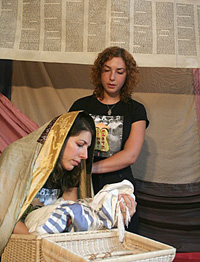The reading and translation of each week’s Torah portion is the longest-running example of continuous performance in human history. Having been passed down for thousands of years, the sacred ritual of performing the weekly parashah fell out of favor about a millennium ago, but one man has made it his career to bring the practice back.
“Traditionally, the Torah service was accompanied by live interpretation and translation into the vernacular, into the language of the day,” says Amichai Lau-Lavie, founder and artistic director of Storahtelling, the organization that performs, literally, the Torah. “The Torah service was the only opportunity in the community for multicultural education and access to Jewish literacy.”
The program, begun in New York’s popular B’nai Jeshurun synagogue when Lau-Lavie served as a scholar-in-residence, now sends troupes of between one and five performers to congregations, schools, and public venues around the country (and sometimes the world) nearly every week. Each troupe comes armed with modern interpretations of the Torah portion as well as educational programs to help communities learn how to do their own versions of Storahtelling. This weekend, they will perform and teach at Temple De Hirsch Sinai.
The goal, Lau-Lavie says, is to make the concept of the Torah as the basis for Judaism accessible to everyone.
“We believe the first thing that needs to happen to open the doors is to understand the text in modern times,” he says, “and second, to give people the permission and authority to open the book…to open the door, to engage in conversation.”
The parashah the troupe will be performing this weekend is called “Field of Dreams,” and discusses Joseph’s attempts to become the Pharaoh’s dream teller. At the center of the weekend, the Saturday evening Havdalah program, the troupe’s maven, the traditional name of the lead storyteller, will guide the congregation through the performance while also seeking audience participation.
“Every time there is a storytelling in place, one of the elements is audience interaction — we always bring it back to people,” Lau-Lavie says. “We always learn from the audiences the things we couldn’t think of ourselves. That’s the beauty of Torah: the 70 faces. There are many ways of celebrating what the story has to say, and that’s the challenge of pluralism.”
Storahtelling is performed at all types of venues — troupes will be performing this weekend at the Conservative movement’s biennial in Orlando and at the Hillel in Binghamton, N.Y. in addition to Temple De Hirsch Sinai — all with slight variations on the same parashah.
“The main role of the storahteller…is to adapt the script, the scripture, to the listeners. As far back as 2,000 years and more, we have records of these translations, and they are different,” Lau-Lavie says. “If I’m working in a congregation that’s multigenerational or multifaith, the points I would like to work on would be slightly adjusted. The stories are the same, the nuances are different.”
The storahtellers who come to Seattle — Lau-Lavie won’t be among them, but Seattle native Chloe Ramras will — are required to have at least some Jewish education before they’ll be brought into the troupe, whether it’s from Hebrew school or summer camp, or even what Lau-Lavie calls “a reawakened passion.”
One role, however, has more stringent requirements: “To be a full-on maven,” he says, “you have to know Hebrew.”
Lau-Lavie’s own background made him uniquely qualified to create what Storahtelling has become. Coming from a long line of rabbis, “I’m a product of an Orthodox yeshiva education for more years than I care to recall,” he says. In his 20s, his work with the secular population in Israel got him interested in the theater, and he then married his two forms of education together.
Seeking to “attempt to salvage synagogue services from not attaining their potential for excitement,” Lau-Lavie launched Storahtelling in 1998 and has been working to connect the Bible to modern dialogue in current events and politics, particularly since 9/11.
“The Bible is not just a religious text, and it’s not just in the hands of people of faith. It’s in the hands of politicians, and it’s in the hands of many political narratives,” he says.
“If the Supreme Court is debating gay marriage, abortion and evolution,” which Lau-Lavie believes will be issues addressed in the upcoming election year, “knowing [the] Bible matters.”
Storahtelling’s weekend at Temple De Hirsch Sinai is but one of many learning programs the Reform synagogue is holding during its “Year of the Torah,” all of which surround the writing of its new Torah. Those programs include giving congregants the ability to learn and write their own Midrash, or Torah commentary — based on the speed-dating concept — as well as a series of adult learning classes that include such titles as “The Torah at 10,000 Feet,” and “If the Scroll Could Talk,” based on facing the ethical dilemmas Lau-Lavie talked about.
“What we’re trying to do with this Torah-writing project is build a sense of community for our congregation and get everyone involved at some level, wherever they feel comfortable,” says Gayle Carrol, Temple De Hirsch Sinai’s special programs manager.
Storahtelling will be held at both Temple De Hirsch Sinai campuses, 3850 156th Ave. SE, Bellevue, and 1441 16th Ave., Seattle, from Fri., Nov. 30—Sun., Dec. 2. Visit www.tdhs-nw.org for a full schedule or contact Gayle Carrol at 206-323-8486 for further details.
